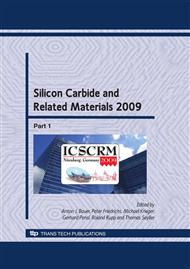p.637
p.645
p.651
p.655
p.661
p.665
p.669
p.673
p.677
Experimental Evaluation of Different Passivation Layers on the Performance of 3kV 4H-SiC BJTs
Abstract:
In this work, the electrical performance in terms of maximum current gain, ON-resistance and blocking capability has been compared for 4H-SiC BJTs passivated with different surface passivation layers. Variation in BJT performance has been correlated to densities of interface traps and fixed oxide charge, as evaluated through MOS capacitors. Six different methods were used to fabricate SiO2 surface passivation on BJT samples from the same wafer. The highest current gain was obtained for PECVD deposited SiO2 which was annealed in N2O ambient at 1100 °C during 3 hours. Variations in breakdown voltage for different surface passivations were also found, and this is attributed to differences in fixed oxide charge that can affect the optimum dose of the high voltage JTE termination.
Info:
Periodical:
Pages:
661-664
Citation:
Online since:
April 2010
Keywords:
Price:
Сopyright:
© 2010 Trans Tech Publications Ltd. All Rights Reserved
Share:
Citation:


